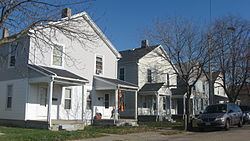Architect Jacob Doffee Moskowitz Area 4 ha Added to NRHP 21 December 1979 | NRHP Reference # 79001900 Year built 1906 | |
 | ||
Kossuth colony historic district top 5 facts
The Kossuth Colony Historic District, named for Lajos Kossuth, is a nationally recognized historic district bounded by Baltimore Street, Mack Avenue and Notre Dame Avenue in Dayton, Ohio. The Kossuth Colony was built in 1906 to house Hungarian immigrant workers for the Barney and Smith Car Company, a rail car manufacturer that ranked among Dayton's largest and most venerable firms. Comparatively few changes have been made to the forty houses in the colony, although the houses' white picket fences have been removed. Many houses in the district are simple gable-front residences with minimal setbacks, and asbestos siding covers many exterior walls in the district.
On December 21, 1979, Kossuth Colony was added to the National Register of Historic Places; it qualified both as an important example of architecture and because of its connection to Jacob Doffee Moskowitz, the labor contractor who was responsible for bringing the Hungarians and constructing the complex. The colony has also been named a historic district by the city of Dayton; one of eighteen districts citywide, it is the only one located northeast of downtown Dayton.
